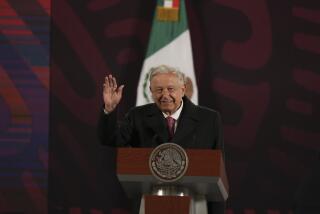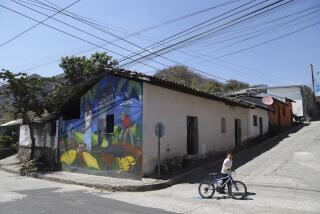Ruling Sandinistas Kick Off Election Campaign : Convention in Managua Nominates Ortega for President on February Ballot
- Share via
MANAGUA, Nicaragua — With an American-style political convention and the slogan “Everything Will Be Better,” the Sandinista National Liberation Front opened its electoral campaign Sunday by choosing President Daniel Ortega and Vice President Sergio Ramirez to run for reelection next Feb. 25.
After a daylong debate among 1,700 party delegates, the Great Convention of the People also adopted a platform endorsing the revolutionary government’s recent turn toward fiscal conservatism and export-led growth to revive the country’s shattered economy.
The festive mood in Managua’s modern convention center, animated by live folk music and hundreds of balloons, was a reflection of the Sandinistas’ enormous advantage over the 14-party coalition led by Violeta Barrios de Chamorro, the strongest of nine opposition candidates.
Clad in red and black neckerchiefs and armed with noisemakers, the delegations of blue-collar workers, farmers, combat veterans, war widows and other interest groups came from a Sandinista network of “mass organizations” that reaches into nearly every town and neighborhood and dwarfs the opposition.
‘Party of Militants’
“In other countries, there are more sophisticated ways of campaigning, but ours is a party of militants,” said Bayardo Arce, the convention chairman. “They give their evenings and weekends to the party. They are always campaigning, and this is our principal asset.”
It was with this edge in mind that the Bush Administration proposed last week to spend $9 million on the election campaign here, some in direct assistance to Chamorro’s war chest and the rest on poll-watcher training and get-out-the-vote drives that will indirectly help the opposition.
The Sandinistas begin the campaign with a nearly 2-to-1 lead in independent opinion polls, with about 40% of the electorate still undecided. They have already begun an intense door-to-door campaign, seeking to identify and win over the uncommitted, and they are counting on contributions from 40,000 active party members, who give 4% of their salaries to the party.
Ortega, 43, who led the decade-old government as junta coordinator before his election as president in 1984, is consistently the most popular candidate in the polls.
He and Ramirez, a 47-year-old novelist and intellectual, were first nominated last May in an unpublicized meeting of the nine-man Sandinista National Directorate, of which Ortega is a member, and the two were ratified by acclamation at the end of the Managua convention Sunday.
In a tribute to Ortega’s growing personal stature in a collective leadership, Interior Minister Tomas Borge, his longtime political rival, gave the nominating address.
“The wisdom of collegial leadership has worked with success in the peculiar conditions of Nicaragua, but we do not deny the role of individuals,” Borge said. “Who has run all over the world, tirelessly defending our point of view? Who has visited every corner of our country, facing the people and listening with infinite patience to complaints, demands and criticism?
“Who? Him!” Borge declared, pointing to Ortega, who sat near him on the dais. Then the two men embraced.
Throughout the day, delegates wore T-shirts reading “Daniel Presidente,” a sign of the convention’s rubber-stamp role.
But Sandinista leaders used the unprecedented public gathering--and the weeks of intense consultations that preceded it--to promote grass-roots participation in other decisions by the party, which is still evolving from its origin as a guerrilla army obedient to its comandantes.
“The Sandinista Front is not a secret society, and this is not a secret meeting,” Ortega said. “This is an example of democracy.”
The proceedings were open to the press and broadcast live on Radio Sandino, the ruling party’s station. Some delegates rose to sing, recite poetry or otherwise praise the party leadership, but others offered blunt criticism.
In the process, about half of the incumbents were dropped from the slate of 180 Sandinistas nominated as candidates for the National Assembly, and several proposals were added to a platform drafted by party leaders--among them calls for greater spending on universities and a more progressive tax structure.
The platform is more specific than the opposition’s in promising progress. It sets goals of 5% annual economic growth--with 6,000 new houses, 1,000 new classrooms and 600 new buses per year--and promises a massive literacy crusade like the one conducted in 1980.
Party officials said these goals are based on assumptions that Ortega will win, that the election will be widely perceived as fair, that the war with the U.S.-backed Contras will not resume and that Washington will eventually offer to renew economic assistance cut off in the early 1980s.
The platform calls for a “respectful agreement” between the Sandinistas and the United States.
More to Read
Sign up for Essential California
The most important California stories and recommendations in your inbox every morning.
You may occasionally receive promotional content from the Los Angeles Times.










